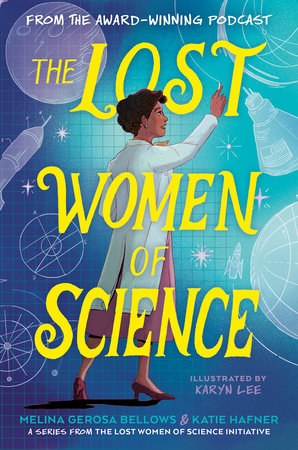From the popular Lost Women of Science podcast, this empowering collection recognizes ten trailblazing female scientists whose lives and works have been lost to history…until now. Here, author Katie Hafner discusses the book’s background, (fantastic!) visuals, and upcoming plans for the series!
THE LOST WOMEN OF SCIENCE started as a podcast (and an incredible, award-winning one at that). What challenges were there turning the podcast into a book, and how did you solve them?
Our mission is to encourage women and girls to be inspired by what female scientists have achieved and to follow in their footsteps and choose science as a career. Our podcasts are more or less aimed at an adult audience, so producing a book based on the podcast seemed like a great way to fulfill our mission. We had done all the research, so it was a matter of retelling those stories in a way that would inspire younger readers. It also meant adding lots of pictures, diagrams and experiments to keep their attention and show how much fun science is. The challenge was getting the tone of the writing and the illustrations just right. We found a great illustrator, Karyn Lee, to design the book.
I love the inclusion of visual materials in the book, from pictures to historical records to timelines to illustrations. How did you and the Lost Women of Science team decide what to include for each subject?
That was not very difficult because each scientist profiled in the book does a different kind of science, so there were lots of materials to pick from, both archival and contemporary. We wanted to include photographs of our scientists, where possible, as well as illustrations that explained the science. For example, for Eunice Newton Foote, who is known now as the Mother of Climate Science, we include an experiment she did, demonstrating that the more carbon dioxide in the air, the hotter that air gets when exposed to the sun. Remember, Eunice was doing this in the mid-1800s in her home laboratory. So, there’s a neat drawing by our illustrator Karyn Lee showing thermometers in glass jars.
The Lost Women of Science Initiative is an educational nonprofit (The Lost Women of Science Initiative), which aims to “inspire girls and young women to pursue education and careers in STEM,” along with education about these remarkable scientists. Was that part of the vision from the start of the project, and how have you seen it flourish?
Yes, that is our vision and that is where the book fits in. We’ve also gone to schools to do presentations about the Lost Women of Science and we are working on creating a resource center that gathers all the materials that we have collected in our research – diaries, photos, scientific papers, letters – in one digital archive so that everyone can have access to them.
You’ve written a variety of mediums throughout your career: articles, podcasts, memoir, fiction, and nonfiction like THE LOST WOMEN OF SCIENCE. Is there a particular style you prefer working in, and do any of these other genres inform how you approach a book like this one?
I’m a journalist through and through, so no matter what I’m working on, I do quite a bit of research and fact-checking. So that’s my guiding principle.
Then there’s the storytelling part. Children and adults alike need to be hooked on a good story. If you tell that story in words that young people can understand, and explain the science in simple English, you’ll find your audience. So that was in the back of my mind when we were working on the text. I’ve been writing about technology and science for years and what you always have to remember is that your readers are often starting out from a very low knowledge base when it comes to a particular subject, so you cannot assume anything. My experience as a journalist helped with that.
The book is listed as a new series, which is exciting to see! What is next for you and the Lost Women of Science team?
The series will consist of three volumes altogether. We’re already hard at work on the second, which will be out in early 2027. Like the first one, this will include women we’ve profiled on the podcast. The book will present their stories, along with lots of illustrations and experiments for kids in middle school. A quick preview: the second book will include a Victorian astronomer who chased eclipses around the world at the turn of the twentieth century, an intrepid paleontologist from California who founded two museums and has many fossils named after her, and the first Black female doctor in America.
About Katie Hafner:

Katie Hafner is the host and co-executive producer of Lost Women of Science. Katie was a longtime reporter for The New York Times, where she continues to be a contributor, writing obituaries and advance obituaries. Katie is uniquely positioned to tell the stories of lost women of science. Not only does she bring a skilled hand to complex narratives, but she has been writing about women in STEM formore than 30 years. She is the author of seven books of nonfiction, and her first novel, The Boys, was published in 2022 by Spiegel & Grau. She is at work on her second novel. Katie is also the host and executive producer of Our Mothers Ourselves, an interview podcast that celebrates extraordinary mothers.

